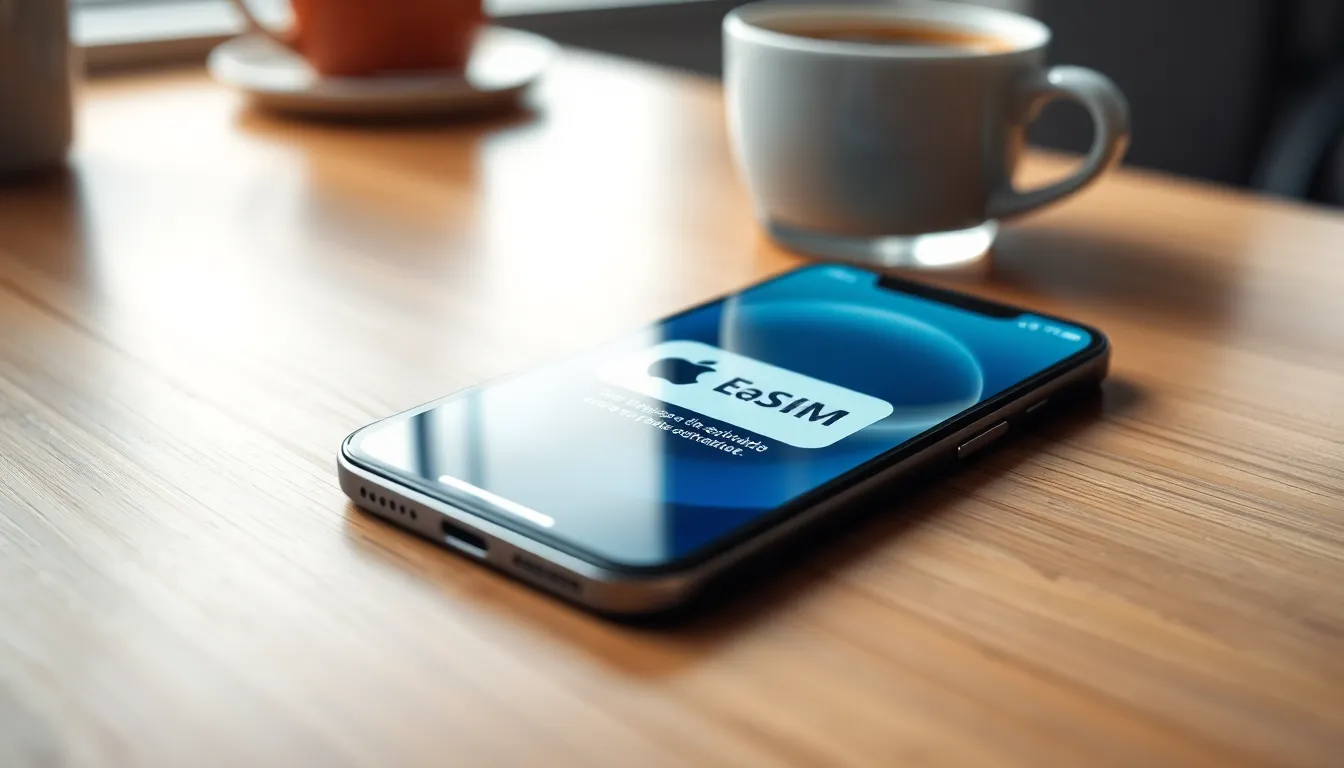In a world where everyone’s glued to their phones, the iPhone 11 stands out with its sleek design and powerful features. But wait—there’s a hidden gem that can elevate your smartphone experience: eSIM. Imagine ditching the bulky SIM cards and embracing a seamless digital connection. It’s like upgrading from a bicycle to a rocket ship!
Table of Contents
ToggleOverview Of eSIM Technology
eSIM technology offers a remarkable advancement in mobile connectivity. The concept eliminates the need for physical SIM cards, allowing users to activate cellular plans directly through their devices. With a simple software update, users can switch carriers or plans without needing to visit a store or replace a card.
Flexibility is a key feature of eSIM. It enables multiple carrier profiles to be stored on a single device, supporting both personal and business lines simultaneously. Travelers can easily add local carriers to avoid roaming charges, streamlining their connectivity while abroad.
Security also benefits from eSIM technology. Its built-in encryption protects user data, reducing the risk of SIM card theft or cloning. Mobile network operators can remotely manage profiles, providing enhanced security measures and easier troubleshooting.
In terms of benefits, eSIM allows for a thinner and lighter device design. iPhone models like the iPhone 11 showcase this benefit, maximizing space for other components while still providing robust connectivity options.
As the mobile industry evolves, eSIM adoption grows alongside 5G advancements. This synergy enhances user experiences, providing faster speeds and improved connectivity solutions. Overall, eSIM technology represents a significant leap forward, simplifying mobile usage and improving accessibility across various markets.
Steps To Add eSIM On iPhone 11

Adding eSIM on an iPhone 11 involves specific steps that ensure successful activation. Follow these instructions to get started.
Checking Carrier Compatibility
Confirming carrier compatibility is essential before proceeding. Many major US carriers support eSIM technology, but not all do. Users should verify with their carriers whether eSIM activation is available. This information typically can be found on the carrier’s official website or by contacting customer service. If a user’s carrier does support eSIM, they can timely benefit from the features it offers.
Retrieving eSIM Activation Information
Retrieving eSIM activation information comes next after confirming compatibility. Carriers provide this information, usually through a QR code or an activation code sent via email or SMS. Users can check their carrier’s online portal or mobile app for details about eSIM provisioning. If the necessary information is missing, reaching out to customer support will likely resolve any issues.
Adding eSIM Plan
Adding the eSIM plan into the iPhone 11 is straightforward. Open the Settings app, then tap on Cellular or Mobile Data. Select “Add Cellular Plan,” and scan the provided QR code. Alternatively, users can manually enter the activation details if needed. Following the prompts will complete the installation process, enabling the new eSIM plan for use.
Troubleshooting Common Issues
eSIM activation may face several common issues. Familiarity with these challenges helps resolve them quickly.
One frequent problem involves carrier compatibility. Ensure the chosen carrier supports eSIM technology. Checking the carrier’s website or contacting customer service verifies compatibility.
Users might experience issues with QR codes. Sometimes the code doesn’t scan correctly, or the activation fails. Meticulously checking the QR code for accuracy is essential. Alternatively, manual entry of the activation code can help bypass scanning problems.
Network settings could also present challenges. Resetting network settings often resolves connection issues. Go to Settings, then select General and Reset. This process restores default settings and may improve eSIM functionality.
Sometimes, errors may occur during data plan addition. In these cases, restarting the device can help clear temporary glitches. After rebooting, repeat the activation steps to see if the issue resolves.
Battery-related problems may affect connectivity. Ensuring the device has sufficient battery life eliminates power issues. Charging the iPhone 11 or using low power mode can improve performance.
Lastly, contacting the carrier can assist with unresolved issues. Providers often have troubleshooting guides or customer support to help users navigate complications. They also offer additional insights on resolving complex situations involving eSIM technology.
Benefits Of Using eSIM On iPhone 11
Using eSIM technology on the iPhone 11 offers numerous advantages. Flexibility stands out, as users can manage multiple cellular plans without needing physical SIM cards. Convenience also plays a significant role since activating a plan can occur directly through the device, eliminating the hassle of inserting and removing SIM cards.
Cost-effectiveness is another benefit, particularly for international travelers. Many can purchase local data plans through eSIM, avoiding hefty roaming charges. Security enhancements add another layer of importance. Built-in encryption and remote management capabilities by mobile network operators provide better protection against fraud.
eSIM contributes to the sleek design of the iPhone 11. This innovation allows for thinner, lighter devices without compromising functionality. Integration with 5G technology further enhances connectivity, resulting in faster speeds and improved performance on mobile networks.
Managing plans becomes straightforward. Users can switch between carriers seamlessly via the Settings app, adapting easily to changing needs. Flexibility in choosing providers helps in selecting the best plans available.
Connectivity issues can also be minimized with eSIM. Troubleshooting becomes simpler, as resetting network settings or restarting the device often resolves minor complications. Consulting with the carrier is straightforward when further assistance is required.
Overall, eSIM functionality on the iPhone 11 enhances user experience through flexibility, cost savings, improved security, and design efficiency. These benefits significantly elevate mobile usability, making eSIM technology an appealing choice for various user profiles.
The eSIM technology on the iPhone 11 transforms how users connect to mobile networks. With its ability to manage multiple plans and streamline carrier switching, it offers unmatched convenience and flexibility. This innovation not only enhances the device’s sleek design but also supports faster connectivity through 5G.
As users navigate the process of adding an eSIM, they can enjoy the benefits of improved security and cost savings, especially when traveling internationally. By following the straightforward steps outlined and addressing any potential issues, users can fully leverage the advantages of eSIM technology. Embracing this feature is a smart choice for anyone looking to enhance their mobile experience.




